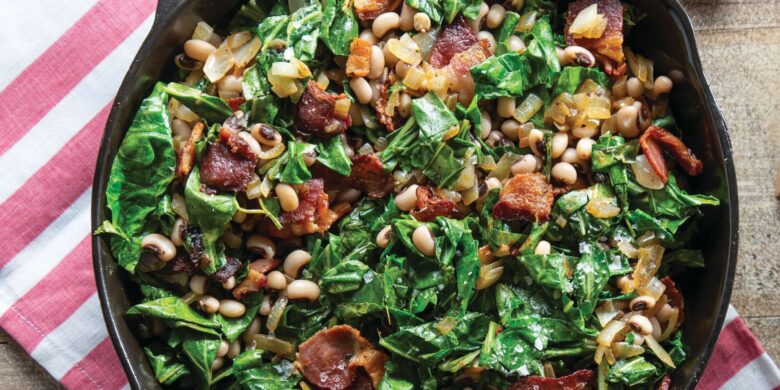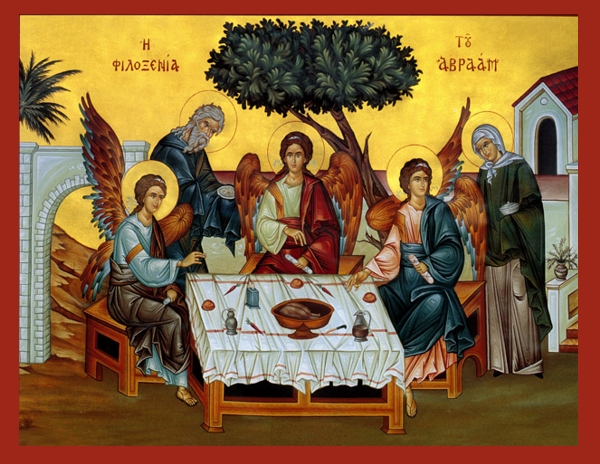Those of you from the South have most likely grown up eating black-eyed peas on New Year’s Day. Typically, they’re served with a “mess” of greens, such as collards, mustard or turnip greens, or even cabbage. Each region has its own tasty ritual.
“Cook your beans low and slow, ideally in a slow cooker. For true Southern-style black-eyed peas, add a smoked ham hock to your pot,” says Lisa Cericola at Southern Living. “The meat will infuse the black-eyed peas with rich, smoky flavor, turning a humble bean into a hearty meal.”
Other salty and savory variations to ham hock include fatback or bacon, hog jowls or ham bones, or even chopped pork or straight ham. But one thing’s for sure: always use dried beans, never canned!
But I thought they were peas, you say? Actually, black-eyed peas are “a variety of bean related to the cowpea and categorized as legumes, having both edible seeds and pods,” remarks Sheridan Alexander at The Spruce Eats.
No matter your recipe, eating black-eyed peas is a Southern tradition said to bring “luck and prosperity” for the the New Year with the peas representing coins and the greens paper money. For those who embellish the dish with tasty cornbread, it is said to represent gold.
Regarding other elements of the tradition, Alexander adds, “For the best chance of luck every day in the year ahead, one must eat at least 365 black-eyed peas on New Year’s Day. Black-eyed peas eaten with stewed tomatoes represent wealth and health.”
“In some areas, actual values are assigned with the black-eyed peas, representing pennies or up to a dollar each and the greens representing anywhere from one to a thousand dollars. Adding a shiny penny or dime to the pot just before serving is another tradition practiced by some. When served, the person whose bowl contains the penny or dime receives the best luck for the New Year.”
These food customs based in a singular tradition aren’t just some kind of weird superstitions or nostalgic folklore. It actually has a historic root dating back to the War Between the States.
“Because of their lowly reputation, the Union Army troops of General [William Tecumseh] Sherman ignored the fields of black-eyed peas while razing or stealing other crops,” Alexander notes of Sherman’s March to the Sea. “During the harsh winter, the Confederate soldiers survived on the remaining black-eyed peas, promoting this humble and nourishing legume into a symbol of fortune and prosperity in the American South.”
That’s a good start for a mainstream food zine and is true but only partly so. The full story is much, much deeper and even more meaningful than that.
“This path of total war or total destruction Sherman’s army cut through the state of Georgia was sixty miles wide and two hundred and eighty-five miles long,” explains Terry Morris in his excellent essay at Identity Dixie. “You’ve seen the terrible devastation that a mile-wide tornado leaves behind it; close your eyes for a moment and try to imagine, if you can, a tornado sixty times that wide and the devastation it would leave in its path, and you will get a pretty accurate picture in your mind’s eye of the devastation General Sherman’s army left behind it during its march from Atlanta to Savannah leading up to New Year’s Day, 1865.”
Morris notes, “General Sherman said himself it was his intention to leave behind him and his army, ‘that most reliable of all Generals – General Starvation.’ Other northern generals said similar things. In other words, northern generals purposely left defenseless women and children, old and infirm people, to starve to death in their army’s wake.”
So, just how did the black-eyed pea play a role in all this horror?
Morris continues:
Our ancestors called them “cow peas because they fed them to their cattle and other animals; some Southerners called them cornfield peas because they planted them in cornfields to keep the soil energized in those fields. Sometimes they planted rows of black-eyed peas in between rows of corn. Anyway, the northern army couldn’t destroy all of the black-eyed peas in the South due to their great abundance. By ‘abundance,’ I mean there were lots and lots of them in all parts of the South, dried and sacked, and stockpiled for feeding their farm animals.”
“You see, black-eyed peas were thought by many people back then, both in the North and in the South, to be ‘animal food,’ not fit for humans to eat. Since the Old South was an agrarian society, it had an abundance of farm animals of every sort, which of course had to be fed and taken care of, and black-eyed peas or corn field peas were a main food source for their animals.”
“That they had [black-eyed peas] in such abundance proved to be the saving grace of many a hungry Southerner, including no doubt some of our own ancestors [who were] left to starve in the wake of General Sherman’s March to the Sea, and his march later through the Carolinas.” Had it not been for their “abundance in the Southland at that time, you and I might not even be here to bring in this New Year in remembrance of the crucial role ‘animal food’ played in saving many of our suffering ancestors from what would have otherwise and most assuredly been death by starvation or disease, if not by exposure to the elements or just plain hopelessness.”
That’s why “we should never think of it as *having* to eat black-eyed peas to bring in the New Year, like it’s a burden to us or something we don’t want to do; we should instead look upon it as an honor and a privilege that we do cheerfully and with gratitude and thanksgiving.”
This is a very Orthodox perspective – not to look at the food tradition as a something we do to receive, but rather, as an act of giving honor to our forefathers and a loving God who provides, especially during times of great struggle. The black-eyed pea was manna for Southern folk during the Late Unpleasantness, but it is He, Christ Jesus, who is manna for all mankind. Through the Holy Eucharist, He is our spiritual sustenance.
The Southern food tradition too is about appreciating and praying for God’s blessing, and not about “luck” in the random, secular sense. It’s about the hope of the Good News, not the Gospel of Excess.
It’s about breaking bread, not making dough. When you sit down with family and friends to eat the Southern comfort food of delicious black-eyed peas and salty greens slow-cooked with love and care, it’s about sacramental living and the Southern and biblical virtue of hospitality, and so too the eternal values of neighborliness and generosity.
“We are called to share everything we have – to give our excess, our abundance – so that others around us may also be given God’s blessings by our hands,” Fr. Marty Watt advises. “It is through our generosity that abundance happens for everyone.”
It’s about “becoming ‘rich toward God.” Like the Apostle Paul teaches in 1 Timothy 6:17-19, “Charge them that are rich in this world, that they be not highminded, nor trust in uncertain riches, but in the living God, who giveth us richly all things to enjoy; That they do good, that they be rich in good works, ready to distribute, willing to communicate; Laying up in store for themselves a good foundation against the time to come, that they may lay hold on eternal life.”
To my fellow “old calendar” Orthodox Christians who haven’t yet celebrated Christmas and are entering into the final stretch of the Nativity Fast, don’t fret that you can’t enjoy your black-eyed peas and greens filled with ham hocks and bacon. Here are a few fast-friendly recommendations from some of the stupendous cooks in my parish family:
“I like cooking collards in a frying pan with oil adding salt, pepper, red pepper flakes. Then to finish it, I squeeze some lemon on it. Pretty good and quick!”
“Adding a capful of minced dehydrated onions to the peas works great,” as does “chipotle in the greens or liquid smoke, or sometimes with hickory-smoked salt.”
“I’m a big fan of layering smoke flavors to replace the taste you would get from pork. My go to combo is chipolte puree, liquid smoke, and a Sazón seasoning packet. I use this in beans and greens but with greens I also add some vinegar, a half a can of diced tomatoes, some diced onion, and a wee bit of sugar to balance the bite. I also like to saute greens in a skillet with the ingredients above bit omit the sugar and canned tomato, and replace it with garlic and fresh cherry tomatoes halved, then make some smokey grits, topped with some hash browns before adding the greens on top for breakfast.”
“If I make cornbread to go with beans or greens during a fast, it’s old-fashioned hot water skillet fried cornbread on an oil day.” Or use a recipe for everyday corn bread and “and simply substitute almond milk and oil instead of milk and butter.”
I pray you all have a happy and fruitful New Year filled with much love, hope, mercy, gratitude, and hospitality. And so I leave you with an excerpt from “Te Deum: A Hymn of Thanksgiving of St. Ambrose of Milan.”
“O Lord, save thy people and bless thine heritage. Govern them and lift them up forever. Day by day we magnify thee, and worship thy Name ever, world without end. Vouchsafe, O Lord, to keep us this day without sin. O Lord, have mercy upon us: have mercy upon us. O Lord, let they mercy lighten upon us, as our trust is in thee. O Lord, in thee have I trusted; let me never be confounded.” Amen.








Comments
Dissident Mama, wishing you a Happy New Year Year to you and your family. Your website and the wonderful work you have done is a breath of fresh air in these stifling times.
Author
Why, that’s a lovely thing to say, Joe! Happy 2023 to you and yours, as well. 🙂
Dissident Mama, what do you think of Whole Foods Market?
Author
I think they’re too expensive so I’m pretty sure I’ve never shopped there. I remember hearing an interview with the founder CEO John Mackey a few years ago and thought he sounded like a reasonable man. Why, do they not sell black-eyed peas cuz that legume is racist?! 😉
https://youtu.be/MQAatkqD01M
Whole Foods sales vegean products and also sales caldenders devoted to the rainbow mafia, Ruth Bader Ginsburg and Maya Angelo. All seems Yankee to me.
Author
Well, I’m glad I’ve never shopped there. I agree with you: ain’t nothin’ more Yankee than radical black poets, zionist judges, and sodomy, pedo, and genital mutilation.
Happy New Year, DM!
My late mother did in fact serve up black eyed peas, with a dime in it for “a happy and prosperous New Year!”. Yep, along with cornbread, turnip greens (often mixed with mustard greens). For years, I didn’t know the origins of our custom, but the story sure makes sense.
I don’t know just how rough our folks had it here in Middle Tennessee, although being occupied early on after the fall of Ft. Donelson, things couldn’t have been great. I do know my ggGrandfather and one of his sons were thrown into the stockade in Dover for refusal to take the loyalty oath to the Union (How long, we don’t know). Also, there was a great deal of partisan activity around here as well. If you’ve read “Jack Hinson’s One Man War”, you get a pretty good idea about how things were in this region.
Still, resorting to the humble yet hearty and reliable black-eyed pea makes a world of sense in such times. It’s sort of like the potato for the Irishman!
Wonderful article and reminder, Miss Rebecca! Thanks!
Author
DD, you’re the second well-read friend who suggested “Jack Hinson’s One Man War,” so I just got it on audiobook. I know a little about him from reading the Nathan Bedford Forrest bio “Bust Hell Wide Open,” but that’s it. So, thanks for the suggestion and the inspiration!
Very cool about your mama and her dime tradition and how the black-eyed pea custom was alive and well and your home. Here’s to a happy and prosperous 2023 … may we have as fortitude and resourcefulness in our own troubled times and make our ancestors proud!
Pingback: Eat your black-eyed peas “with gratitude & thanksgiving”